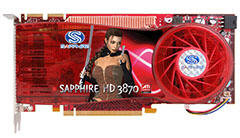First look at the ATI Radeon HD 3870

Yesterday I received a nice surprise in the mail - a box from ATI containing a Radeon HD 3870. Unfortunately, I was in the grips of a nasty bout of stomach flu and not even the prospect of better frames per second couldn't convince me that it was a good idea to crack open my PC and start messing inside it.
Am I pleased with the switch? Well, so far this emoticon says it all really ... :-DToday,
The HD 3870 is a graphics card that has it all - 512MB of GDDR4 memory, DirectX 10.1 support (which means mandatory 32-bit floating point filtering, mandatory 4x anti-aliasing and shader model 4.1), HDMI support, HD support and CrossfireX support. The card's RV670 GPU boasts 666 million transistors and uses a 55 nm fabrication technology which means more performance per watt for the end user. The core clock runs at 775MHz and the memory clock at 2.25GHz (compare this to the HD 2900 XT where the core ran at 740MHz and the memory at 1.65GHz). The GPU has a math processing rate of 497 gigaFLOPs. All these numbers are blindingly impressive but what really matters is how the card works in the real world!
The only drawback to the HD 3870 compared to the 2900 XT that I can see so far is memory bandwidth. The 2900 XT offers a 512-bit wide bus while the 3870 only offers a 256-bit bus.
The card is big, much bigger and heavier than the 2600 XT it was replacing, and because it takes up two PCI slots (one for the video outputs and one for the exhaust) I had to reorganize other things I had fitted in the PC to make room for the card. Then I made a silly mistake (I blame the flu and my cold medicine riddled brain for this) and forgot to fit the 6-pin PCI-E power cable. The PC booted up just fine without it but when Windows tried to load the drivers the system started screaming like a banshee, which was enough to remind me what I'd done wrong and stir my headache back into life.
With the power issue figured out it was time for a reboot. Something that I've noticed is that at system startup the fan on the card spins at high-speed for about a second and at this point it's pretty noisy. Fortunately, this isn't the sign of things to come and the fan falls to a noise level that's near silent. This time Windows installed the hardware correctly and things were ready to test.
I've also run 3Dmark06 on the system (SM2.0 tests 1 and 2, HDR/SM3.0 tests 1 and 2, and CPU tests 1 and 2) and got a score which beat the 2600 XT by nearly a factor of 2 at 1024 x 768 and 1280 x 1024.
I'll post more detailed benchmarks soon but my initial testing indicates that this card comes close to but doesn't quite reach the performance offered by an nVIDIA 8800GT [UPDATED: Sorry, I meant to say 8800GT and not GTS], but you have to offset that against the fact that the HD 3870 is cheaper than the 8800GT. If you're looking to spend around $300 for a card, then the 8800GT is going to be a better bet (as long as you like the nVIDIA drivers, which I don't), but if you're looking to spend closer to $200 then you won't beat the HD 3870. If you're a gamer looking for a cost-effective way to upgrade your system, I'd add an HD 3870 to my wish list quick!
Retail price for the HD 3870 is somewhere in the region of $220.
Thoughts?